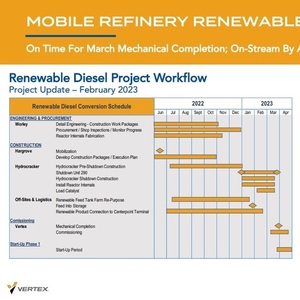Vertex Energy to begin renewable diesel production in April

March 7, 2023
BY Erin Krueger
Vertex Energy on Feb. 28 confirmed that the renewable diesel conversion project at its refinery in Mobile, Alabama, is on track to be mechanically complete in late March, with initial production volumes expected in April.
The company in May 2021 announced it had entered into a definitive agreement to acquire the Alabama refinery from an affiliate of Royal Dutch Shell and convert a portion of the facility to renewable diesel production.
Vertex is converting the refinery’s existing hydrocracking unit to produce renewable diesel fuel on a standalone basis. The company completed shutdown of the hydrocracker unit on Jan. 6. As of Feb. 28, approximately 55 percent of shut-down related work was complete. Catalyst loading was expected to begin in early March.
Once the conversion project is complete, the facility is expected to have an initial nameplate capacity of 8,000 barrels per day (122.64 MMgy). Installation of additional hydrogen supply is expected to expand capacity to 14,000 barrels per day by early 2024.
Advertisement
Advertisement
Advertisement
Advertisement
Related Stories
The U.S. Energy Information Administration maintained its forecast for 2025 and 2026 biodiesel, renewable diesel and sustainable aviation fuel (SAF) production in its latest Short-Term Energy Outlook, released July 8.
XCF Global Inc. on July 10 shared its strategic plan to invest close to $1 billion in developing a network of SAF production facilities, expanding its U.S. footprint, and advancing its international growth strategy.
U.S. fuel ethanol capacity fell slightly in April, while biodiesel and renewable diesel capacity held steady, according to data released by the U.S. EIA on June 30. Feedstock consumption was down when compared to the previous month.
XCF Global Inc. on July 8 provided a production update on its flagship New Rise Reno facility, underscoring that the plant has successfully produced SAF, renewable diesel, and renewable naphtha during its initial ramp-up.
The USDA’s Risk Management Agency is implementing multiple changes to the Camelina pilot insurance program for the 2026 and succeeding crop years. The changes will expand coverage options and provide greater flexibility for producers.
Upcoming Events










